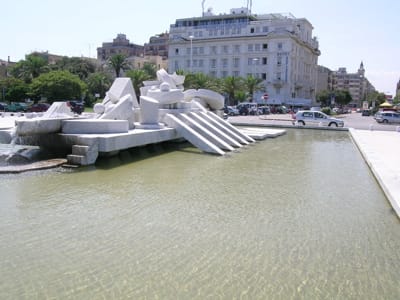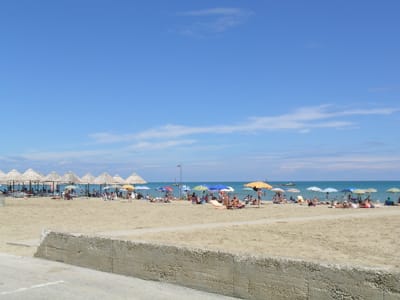ソレント市からナポリ方面へ約50キロ、ポンペイ市へ到着しました。
ポンペイといえば遺跡、ですね。紀元79年、ベスビオ火山の噴火により
火山灰に埋まってしまったこの古代都市は、当たり前ですが、ベスビオ火山の
お膝元にあります。ポンペイ市自体は現代の町で、遺跡区域を擁しています。
我々が訪れた当日(9月23日)は、偶然「遺跡の日」にあたっていたようで、
入場料(通常は11ユーロ=1650円くらい)が無料でした。ラッキー!!
中に入るとその広さと保存状態の良さにびっくりでした。石畳の大通り、
表札やフレスコ画の鮮明に残る立派な街並み、各種商店が軒を連ね、
水道網が発達していて、どれほど豊かな大きな街だったかがわかります。
円形劇場などはそのまま現在でも使えるそうです。これが日本で言えば、
弥生時代に既に完成されていたかと思うと二度びっくりですね。
ところで遺跡区域内には、なぜだか大きな野犬がたくさんいました。
古代ポンペイ市にはたくさんの犬が飼われていたとのことですが・・・
演出だったのでしょうか、自然に棲みついたのでしょうか、謎です。
上の写真は中心街と言われたアッボンダンツァ通り(Via dell'Abbondanza)。
人々で賑わっていると、まるで遺跡の中などでなく、普通の町のようでは
ありませんか?下の写真は町の中心に位置する公共広場(フォロ Foro)と、
ベスビオ火山です。
ポンペイの詳細情報はこちらからどうぞ:
NHK世界遺産
TBS世界遺産
南イタリア旅行記はこれでおしまいです。お付き合いありがとうございました。


Driving about 50Km from Sorrento city toward Naples, we arrived
in the city of Pompei.
"Pompeii" reminds you of the Roman ruins, doesn't it? The ancient
city of Pompeii, which had been burried under volcanic ashes since
the Mount Vesuvius erupted in AD 79, is (of course) located at
the foot of Mount Vesuvious. Today, the modern city of Pompei is
surrounding the ruins area.
The day we have visited Pompei (September 23) was the "Herritage
Day" and the preserved area was entrance free (normal charge is
11 euro = about 1,650 yen). What a lucky coincidence!!
Once we entered in the ruins area, it surprised me how large the
area is and how remarkably the ancient town remains its original
shape. Stone-paved avenues, well-preserved doorplates and Flescoes,
various stores and shops lining along the streets, perfect water
services - all these factors clearly show how big and rich the city
used to be. Theatres can be used even today.
Isn't it a second surprise that this city had already been developped
at the time of Yayoi era in Japan?
By the way, we saw many big stray dogs in the ruins area.
It is said that also in ancient Pompeii a lot of dogs were kept...
But was it a "stage direction" or did these dogs begin to live in
that area by themselves?
The above picture is "Via dell'Abbondanza," the main street of
Pompeii. Doesn't it look like a normal town when it is alive with
people like this? The latter picture is the view of the Mount
Vesuvius from "Foro", a public place at the center of Pompeii.
Please find more about Pompeii from here::
UNESCO's official website
This is the final episode of our travel to South Italy.
Thanks for reading them all!
ポンペイといえば遺跡、ですね。紀元79年、ベスビオ火山の噴火により
火山灰に埋まってしまったこの古代都市は、当たり前ですが、ベスビオ火山の
お膝元にあります。ポンペイ市自体は現代の町で、遺跡区域を擁しています。
我々が訪れた当日(9月23日)は、偶然「遺跡の日」にあたっていたようで、
入場料(通常は11ユーロ=1650円くらい)が無料でした。ラッキー!!
中に入るとその広さと保存状態の良さにびっくりでした。石畳の大通り、
表札やフレスコ画の鮮明に残る立派な街並み、各種商店が軒を連ね、
水道網が発達していて、どれほど豊かな大きな街だったかがわかります。
円形劇場などはそのまま現在でも使えるそうです。これが日本で言えば、
弥生時代に既に完成されていたかと思うと二度びっくりですね。
ところで遺跡区域内には、なぜだか大きな野犬がたくさんいました。
古代ポンペイ市にはたくさんの犬が飼われていたとのことですが・・・
演出だったのでしょうか、自然に棲みついたのでしょうか、謎です。
上の写真は中心街と言われたアッボンダンツァ通り(Via dell'Abbondanza)。
人々で賑わっていると、まるで遺跡の中などでなく、普通の町のようでは
ありませんか?下の写真は町の中心に位置する公共広場(フォロ Foro)と、
ベスビオ火山です。
ポンペイの詳細情報はこちらからどうぞ:
NHK世界遺産
TBS世界遺産
南イタリア旅行記はこれでおしまいです。お付き合いありがとうございました。


Driving about 50Km from Sorrento city toward Naples, we arrived
in the city of Pompei.
"Pompeii" reminds you of the Roman ruins, doesn't it? The ancient
city of Pompeii, which had been burried under volcanic ashes since
the Mount Vesuvius erupted in AD 79, is (of course) located at
the foot of Mount Vesuvious. Today, the modern city of Pompei is
surrounding the ruins area.
The day we have visited Pompei (September 23) was the "Herritage
Day" and the preserved area was entrance free (normal charge is
11 euro = about 1,650 yen). What a lucky coincidence!!
Once we entered in the ruins area, it surprised me how large the
area is and how remarkably the ancient town remains its original
shape. Stone-paved avenues, well-preserved doorplates and Flescoes,
various stores and shops lining along the streets, perfect water
services - all these factors clearly show how big and rich the city
used to be. Theatres can be used even today.
Isn't it a second surprise that this city had already been developped
at the time of Yayoi era in Japan?
By the way, we saw many big stray dogs in the ruins area.
It is said that also in ancient Pompeii a lot of dogs were kept...
But was it a "stage direction" or did these dogs begin to live in
that area by themselves?
The above picture is "Via dell'Abbondanza," the main street of
Pompeii. Doesn't it look like a normal town when it is alive with
people like this? The latter picture is the view of the Mount
Vesuvius from "Foro", a public place at the center of Pompeii.
Please find more about Pompeii from here::
UNESCO's official website
This is the final episode of our travel to South Italy.
Thanks for reading them all!



























